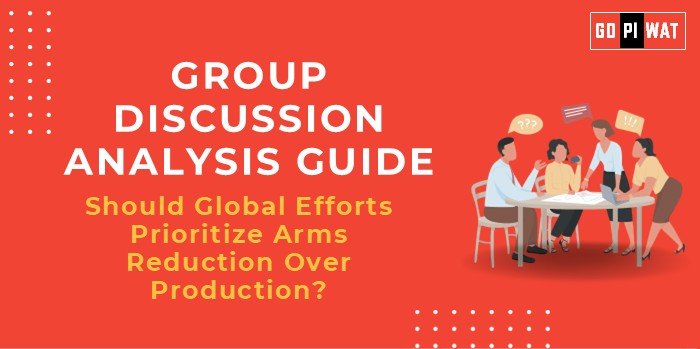📋 Group Discussion (GD) Analysis Guide
🌐 Should Global Efforts Prioritize Arms Reduction Over Production?
📖 Introduction to the Topic
Opening Context: The world spends over $2 trillion annually on arms, creating a paradox of escalating security needs and persistent threats of violence. Should global efforts address the root causes and the scale of arms production?
Topic Background: Arms production, fueled by geopolitical tensions and economic interests, has existed for centuries. Recent international calls for disarmament and treaties like the UN Arms Trade Treaty underscore the need for collective action.
📊 Quick Facts and Key Statistics
- 🌍 Global Arms Trade: Over $100 billion annually, showcasing the massive economic stake.
- 💼 Military Expenditure: $2.24 trillion (2023), highlighting the prioritization of arms.
- ☢️ Nuclear Warheads Worldwide: Approx. 13,000, revealing the magnitude of destructive capacity.
- 📈 Top Arms Exporters: USA (39%), Russia (19%), France (11%) – emphasizes key players in the market.
🌟 Stakeholders and Their Roles
- 🏛️ Governments: Drive production and set policy frameworks.
- 🌐 International Organizations: UN promotes treaties and peacekeeping efforts.
- 🏢 Private Sector: Corporations innovate and manufacture weaponry.
- 👥 Citizens & NGOs: Advocate for disarmament and peace.
🏆 Achievements and Challenges
✨ Achievements
- ✅ Reduction Treaties: START has significantly reduced nuclear warheads.
- 🤝 Peacekeeping Success: Missions helped stabilize conflict zones.
- 💡 Innovations: Development of non-lethal technology for defense purposes.
⚠️ Challenges
- ⚔️ Arms Races: National security concerns drive competition.
- ⚖️ Dual-Use Technologies: Complicates regulation due to civilian and military applications.
- 📉 Inequities: Uneven compliance with disarmament treaties.
📘 Global Comparisons:
– Success: Scandinavia’s adherence to disarmament treaties.
– Case Study: Post-apartheid South Africa relinquished nuclear arms, showcasing a unique example.
– Challenges: Rising arms production in Asia.
💬 Structured Arguments for Discussion
- ✅ Supporting Stance: “A global initiative can mitigate conflicts and redirect funds to social development.”
- ❌ Opposing Stance: “Arms production ensures national security and economic growth for key industries.”
- ⚖️ Balanced Perspective: “While necessary for defense, unchecked arms production fuels conflict; regulation is key.”
💡 Effective Discussion Approaches
- 🌏 Opening Approaches:
- “Highlight economic vs. humanitarian costs using statistics.”
- “Present a case study of successful disarmament like New Zealand’s nuclear-free stance.”
- 🤔 Counter-Argument Handling:
- Question economic reliance on arms by comparing industries like renewable energy.
- Cite peace dividends from disarmament agreements.
🔍 Strategic Analysis of Strengths and Weaknesses
- 💪 Strengths: Peacebuilding potential; cost savings redirected to development.
- ⚖️ Weaknesses: Enforcement difficulties; resistance from powerful arms-exporting nations.
- 📈 Opportunities: Strengthened global alliances; advancement of defense alternatives.
- ⚠️ Threats: Geopolitical tensions undermining initiatives; black-market proliferation.
🎓 Connecting with B-School Applications
- 🌍 Real-World Applications: Explore links to supply chain management, global finance in defense, and conflict resolution projects.
- 💬 Sample Interview Questions:
- “How can arms reduction initiatives impact global economies?”
- “What lessons can businesses learn from disarmament treaties?”
- 💡 Insights for Students:
- Study defense economics and its impact on global trade.
- Analyze public-private partnership roles in arms reduction efforts.


